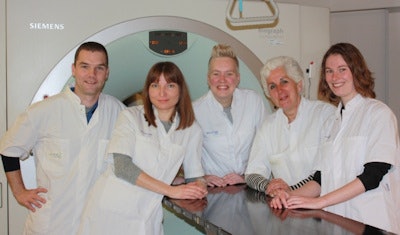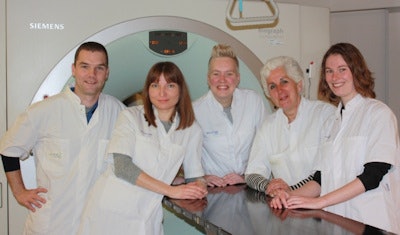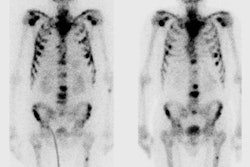
Radiotherapy of heterogeneous tumors containing regions of hypoxic or hypermetabolic cells can prove less than optimal due to the presence of radioresistant subvolumes. Nonuniform irradiation -- or dose painting -- is under investigation as a more effective treatment for radiobiologically heterogeneous targets. The idea is to prescribe a nonuniform dose distribution to the tumor, based on image-guided identification of potentially radioresistant biological target volumes (BTVs).
Dose-painting is usually implemented by delivering increased dose to radioresistant regions. But according to Ala Yaromina from MAASTRO Clinic in Maastricht, the Netherlands, in some cases, the opposite may hold true. Along with her colleagues, she is looking at conventional dose painting and a new approach called inverse dose painting.
Defining the target
The BTV in a tumor can be determined using molecular imaging. PET scanning with the tracer F-18 FDG, for example, will pinpoint regions of high metabolic activity. "Dose painting combines anatomic imaging with biological information to define radioresistant tumor subpopulations that would be good targets for dose escalation," Yaromina explained. "Clinical data support FDG uptake as a promising target for radiation dose escalation."
To examine the feasibility of this approach, Yaromina et al studied dose painting based on FDG uptake in a rat rhabdomyosarcoma tumor model. The animals were injected with FDG and PET/CT scanned two hours later. The image was processed to define the BTV, according to the tracer uptake, and used to create a volumetric-modulated arc therapy (VMAT) plan. Finally, the animals were positioned on a RapidArc treatment system using cone-beam CT and the treatment delivered. She presented the findings at the 3rd Symposium on Small Animal Precision Image-Guided Radiotherapy, held last month in Ghent, Belgium.
 The main research team involved in the dose-painting studies. From left to right: Ludwig Dubois, Ala Yaromina, Natasja Lieuwes, Marlies Granzier, and Rianne Biemans.
The main research team involved in the dose-painting studies. From left to right: Ludwig Dubois, Ala Yaromina, Natasja Lieuwes, Marlies Granzier, and Rianne Biemans.The researchers first performed a targeted dose escalation study comparing hot and cold boost strategies. The BTV was defined as the 30% of gross tumor volume (GTV) with the highest (BTVhot) or lowest (BTVcold) FDG uptake. For the hot boost regime, BTVhot received a dose of 15 Gy while the rest of the GTV received 10.7 Gy; for the cold boost, BTVcold received 15 Gy while the remaining GTV received 10.7 Gy. The mean dose to the GTV was 12 Gy in all cases.
Comparisons of the time taken to reach twice the starting tumor volume after treatment revealed no difference in tumor response between the hot and cold boost regimes. "Dose escalation to high- and low-FDG uptake subvolumes was equally effective," Yaromina said, adding that the investigation demonstrated high dosimetric accuracy dose painting studies are technically feasible in medium-sized animals on a clinical platform.
In parallel, they examined dose redistribution, comparing the hot boost regime with uniform 12 Gy irradiation to the entire GTV. In terms of tumor growth delay, the hot boost did not improve upon results from uniform irradiation. When the experiment was repeated at 8 Gy (10 Gy to BTVhot and 7.1 Gy to the rest of the GTV, versus uniform 8 Gy dose), the hot boost was actually detrimental to the outcome. Yaromina suggested these data support the hypothesis that tumor response is dependent on the minimum intratumoral dose, rather than the highest BTV dose.
The inverse approach
Tumor hypoxia is another promising target for dose escalation, but hypoxic tumor cells are two to three times more radioresistant and such a dose escalation is difficult to achieve clinically, Yaromina told the audience. "So the idea is to target hypoxic cells with the hypoxia-activated prodrug TH-302 and to deliver a higher radiation dose to the regions with low drug accumulation, so-called inverse dose painting based on drug uptake," she explained.
In this inverse dose painting approach, the team targeted hypoxic tumor cells with TH-302, which is expected to accumulate in a similar pattern to the F-18 HX4 hypoxia tracer. The researchers performed a pilot study of rats with rhabdomyosarcoma tumors. They used HX4 PET to define tumor subvolumes of LDUV (low drug-uptake volume, the 40% of the GTV with the lowest HX4 uptake) and HDUV (high drug-uptake volume, the 40% with the highest HX4 uptake).
The researchers examined several treatment arms: TH-302 or saline plus a 50% boost to the LDUV; TH-302 plus a 50% boost to the HDUV; and TH-302/saline with a uniform boost to the entire GTV. To assess tumor response, they evaluated the time taken to reach three times the starting tumor volume.
The LDUV boost regime combined with TH-302 -- which delivered 18.4 Gy to the LDUV and 12.1 Gy to the remaining GTV -- proved more effective than the HDUV boost (18.8 Gy to the HDUV and 12.3 Gy to the remaining volume). Tumors in the LDUV boost arm that received saline instead of TH-302 exhibited a worse response, demonstrating TH-302 kills hypoxic cells.
Preliminary results showed a uniform boost dose of 18.5 Gy to the entire GTV provided a similar outcome to the LDUV boost. This suggests the proposed inverse dose painting strategy is as effective as uniform dose escalation to the entire tumor, but with a greater capacity to spare normal tissues. These results are currently being validated in the ongoing study. "Dose painting based on the uptake of labeled drugs may prove a promising strategy to pursue further," Yaromina said.
Yaromina concluded her presentation by explaining while these experiments were performed successfully using a commercial linac, moving to a precision small-animal image-guided irradiator such as the X-RAD SmART could increase flexibility. "This would also let us use smaller animals such as mice, decreasing the cost of experiments," she said. Importantly, higher resolution microPET would reveal more detail regarding the distribution of dose painting targets within a tumor.
"The question still remains whether we can deliver even more complex dose distributions."
© IOP Publishing Limited. Republished with permission from medicalphysicsweb, a community website covering fundamental research and emerging technologies in medical imaging and radiation therapy.




















